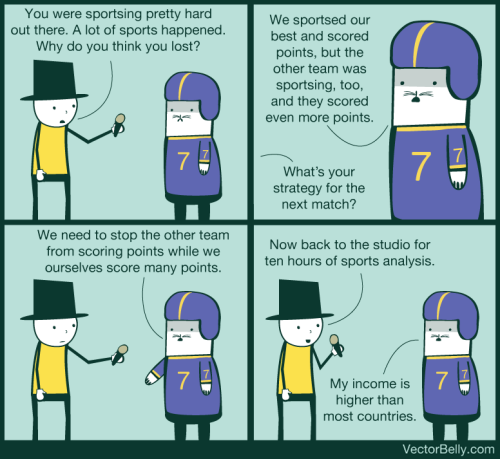This quote from Harry Reid (D-NV) bears repeating ...
"Ted Cruz is smart. He has always been able to talk down to people. He is now in the Senate. People are as smart as he is. He can't talk down to anyone anymore. But he has still not accepted that in his own head. He still thinks he's smarter than everybody else. He might be able to work a calculus problem better than I can. But he can't legislate better than I can."
This is some expert trolling by Reid and deserved stomping on Cruz after Reid turned his gambit down to a crushing defeat. But it also captures some of what's happening to Cruz.
As I mentioned before, back when he showed up at Harvard Law School in 1992, he stunned his fellow classmates by putting up flyers around campus for an 'elite study group' with the instructions 'only magnas from top Ivys need apply.' In other words, at a place where arrogance is like air and self-awareness a precious commodity, Cruz managed to stand out on day one as a triple-ply arrogant ass.
Cruz never seems to have grasped that there are people every bit as sharp as him who didn't go to an Ivy League School (even a 'top Ivy'). My read on Cruz, from talking to people who knew him very well in college and law school, is that he's so confirmed in his belief in his own rectitude and genius that he's likely impervious to what most of us would interpret as rejection or failure. This didn't work? Well, too many stupid people or cowards who didn't flock to my banner. That seemed to be the gist of his speech before the vote. And my guess it wasn't just puffing but represented his genuine belief.
Remember, this is a man who by all accounts is 100% focused on being the 2016 Republican presidential nominee who has quickly racked up a cosmically abysmal level of popularity nationwide. According to the latest NBC/WSJ poll, he has a 14% approval rating nationwide, with 28% disapproving of him. Now he's back to saying that he can't rule out shutting down the government again.
He won't turn back. He's impervious to negative feedback. The only question now is what do other power players in the GOP do with him.
by digby
I think this is an important insight:
The problem Republicans are having right now is an outgrowth of a longer-term issue they've had ever since the 2008 elections: the GOP does not really have much of a policy agenda. For the past five years, the party has been defined almost entirely by everything it is against. Mostly, it is against Barack Obama and whatever he is for. And here, Mr Obama's tendency to play the reasonable moderate sometimes becomes a problem. It's a deep-seated element of Mr Obama's character to step back from disputes, to take things to a meta level, to describe the arguments on both sides and then present his own solution as a compromise, or simply to plead for reasoned debate and a sense of common purpose. There are times when this approach does no one any good.And it would be especially useful if he stopped doing it as we careen toward a default with the likely result of making the Republicans more likely to back themselves even further into their corner. Just a few minutes ago he once again laid out all the reasons why a default is terrible and then said that he is more than willing to talk about entitlements, admits that sequestration is rough but he gets that Democrats have to go along, brags that he's adopted many Republican ideas and then winds up with the usual promise to sit down and make even more deals after the debt ceiling is lifted.
When Mr Obama stops speaking as a partisan advocate of ambitious liberal goals, adopts his mature school-principal voice, and demands simply that political players adhere to reasonable norms of democratic governance, Republicans are left with nothing to oppose except the reasonable norms of democratic governance.
As this piece points out, he's making it harder for the Republicans to capitulate by insisting on being the grown-up in the room. They have to move even further right because the only thing these haters can do to feel like they've won anything is to oppose the already compromised position the president inhabits and move everything further right. It's a problem.
.
I played football in high school, specifically offensive line, defensive line, and linebacker. So did my older and younger brothers, and my older brother coaches linemen and defense at a high school in Michigan. I started out first in middle school and high school as a defensive specialist, which makes sense given John Madden's theory of linemen.
Madden used to say that offensive linemen were overwhelmingly big kids who grew up to be big men, who'd always been told not to pick on but to protect kids smaller than them. Defensive linemen, on the other hand, were little kids who grew up fighting with other little kids (and often bigger kids) but who grew up to be big men. That's what I was: a skinny kid who became a fat adolescent who became a big, strong teenager. (Now I'm a strong, fat writer, so that's how that turned out.)
Madden said the problem was that offensive linemen still needed to be as tough and aggressive as defensive linemen, but they'd always hold something back. Some of this is part of the rules of football: offensive linemen literally can't do everything a defensive lineman can do to them. So what Madden would do is take a tackling dummy and let his offensive linemen beat the hell out of it. Punch it, tear it, throw it across the room, it doesn't matter. Help them get to a point where they're no longer worried about being over-aggressive.
College football reporter Spencer Hall writes:
You should know this about offensive line coaches: they are large, demanding men with Falstaffian appetites, jutting jaws, and no governors on their speech engines. They eat titanic portions. They cram their lips full of dip in film study like they are loading a mortar. They drink bottled water like parched camels, and in their leisure time would consider a suitcase of beer to be a personal carry-on item for them, and them alone. They are terrifyingly disciplined in the moment, and nap like large breed dogs when allowed.
Now, even if Madden's amateur psychobiography of linemen were true when he was coaching, it's not true any more. In the 1990s, coaches got really good at taking tall but relatively slender athletes from every position, bulking them up, and sticking them at offensive line.
In high school, we played this guy named Jon Jansen, who ended up becoming a star offensive tackle for the Washington Redskins before coming home to Detroit and playing one year for the Lions before becoming an announcer. In high school though, he weighed almost 100 pounds less than he did as a pro. He was listed then at 6'8", 230 lbs, and played tight end and middle linebacker. He was FAST. They moved him all over the field, catching touchdowns and uprooting people. It was chaos.
He went to Michigan, they redshirted him for his freshman year, and came back weighing 300 lbs and playing offensive line. Jansen told Bob Costas that he thought between 15 to 20 percent of NFL players were using illegal performance enhancing drugs, noting that the NFL didn't then test for human growth hormone. I remember when I was still in high school reading a long profile of the University of Nebraska's offensive linemen that attributed their huge gains in mass and strength to weightlifting and creatine. Draw your own conclusions about what was happening in pro and college football at the time.
This is all to say that what offensive linemen do in football is not well understood. When the NFL finally started to act on widespread concussions and the resultant uptick in chronic traumatic encephalopathy — if you never have, please read about the life and death of Dave Duerson — they focused on open-field helmet-to-helmet hits and defensive players targeting quarterbacks, running backs, and receivers (so-called "skill positions"). They ignored the constant battering that offensive linemen take, how repeated brain injury poses the greatest risk for long-term problems, how linemen are rewarded for staying on the field and playing through pain, and the ways in which they're encouraged to both be more aggressive and prioritize someone else's safety over their own.
Kurt Vonnegut said that his chief objection to life in general was that it was "too easy, when alive, to make horrible mistakes." This is what offensive line coaches live with: the notion that for every five simple circles drawn on a board, there are a nearly infinite number of possible threats looming out in the theoretical white space. Offensive plays give skill players arrows. Those arrows point down the field toward an endzone, a stopping point, a celebration. Those five simple circles stay on the board in the same place, and are on duty forever.
They are rough men in the business of protection.
Today, Hall has one of the most beautiful, thoughtful, human pieces on offensive linemen I've ever read, and which I've been quoting here throughout. It's called "The Business Of Protection," and subtitled "It Is Never, Ever About You." It's a story about Vanderbilt University's offensive line coach Herb Hand, who suffered a sudden and deadly brain hemorrhage waiting in line at a hotel breakfast bar on a recruiting trip. But Hand's story manages to become equally about football, fatherhood, the brain, the heart, how we defend ourselves from what's horrible in the things we love, and how we defend the people closest to us from ourselves.
When Hand had to have the impossible conversation — the one where you, with cellphone, stuck in a hospital far away from home, might have to say the last words you ever say to your children — he did what he was trained to do. He told them that he loved them, and that everything would be okay. The second part of that might not have been true at the time. The emergency room doctor certainly didn't think so, and neither did Hand. But standing between harm and others is what linemen do, even if there's little hope to be had in the face of numbers, size, and speed. There is a dot on the board, and a shield held against whatever slings and arrows lurk in the ether. It stands against harm until it cannot any longer.
Update: While I was writing this post, the NFL and 4500 former players (about one-third of the 12000 still living) reached a mediation agreement to settle a number of lawsuits over concussions for $765 million.
This figure includes legal fees, medical exams, the cost of noticing former players, and $10 million for research and education on the long-term effect of brain injuries, leaving $675 million to compensate former players who've suffered cognitive injuries (or, if dead, their families). The settlement applies only to players who've retired by the time court approves its terms. Current players will need a separate agreement to be compensated for existing and future injuries, and the NFL admits no liability.
As Buzzfeed sportswriter Erik Malinowski notes on Twitter: "Holy crap, what a bargain... ESPN pays $1.9 billion *every year* for Monday Night Football. 4,500 ex-players will get 40% of that (once) for decades of head trauma."
Tags: brainfootballHerb HandmatterSpencer HallsportsI’ve been doing a lot of technical things lately, writing up our repair data and investigating methods of reducing optical variation in lenses. So I thought I’d take a bit of a break and write a post about something fun. Human vision is always fun to me, since it’s an area where I can apply both my photography and medical experience.
Most of you probably know some of these things, but I bet most of you don’t know all of them. So I would recommend skimming along this rather long post to find the topics that interest you.
Carrots
Did your mother ever tell you to eat your carrots because it would improve your eyesight? You know that isn’t true, right? But did you know that this urban myth began as a government-sponsored disinformation program? Don’t get all politically hackled, it was back in the 1940′s. Great Britain had deployed radar-guided night fighters and knew Germany would notice a sudden increase in the number of planes shot down.
Great Britain decided to take care of two things at once: They needed to keep the Germans from finding out how good their radar system was and they were rationing almost every food imaginable and trying to get people to plant vegetable gardens. So they released a story that their leading night-fighter ace, John Cunningham, was nicknamed ‘Cat’s Eyes’ because of his amazing night vision that let him see German planes in the dark. Then they followed up by saying they’d discovered his night vision was so good because he ate massive quantities of carrots and they had started feeding carrots to all of their pilots with amazing results.
This not only fooled the Germans, it got British citizens planting carrots in their backyards so they could see at night during the blackouts. It also caused my mother to force feed me carrots as a child and I hate them to this very day.
As an aside, did you know that carrots come in lots of colors besides orange? Actually, the original carrots were purple. Dutch breeders in the 1700s created the orange carrots we’re all used to. Makes you feel rather inadequate about that little team flag in your front yard, doesn’t it? When the Dutch want to display their team colors they create a whole new vegetable.

- Carrot colors. Original images http://www.carrotmuseum.co.uk/
What has this to do with photography you ask? Well it provides a superb segue to talk about color vision, that’s what. OK, maybe not superb, but it’s decent. And I’ve been trying to work that carrot story into a blog post for months.
Color and Monochrome Vision
Pity Us Mammals
Most of the so-called ‘lower animals’ like birds, reptiles, insects, and fish have four types of cones cells and can distinguish far more colors than we can. There is some evidence that pigeons (AKA flying rats) actually have five types of color sensing cone cells, making them the color vision champion of the animal kingdom. They can even see into the ultraviolet spectrum. This probably explains why your pet pigeon isn’t too interested in your brightly colored photographs; he would find them dull and lifeless. (On lifeless (on the other hand, we humans don’t fly full speed into mirrored buildings, so I guess there’s always a trade-off.) buildings).

- Wavelength sensitivity of the 4 cone receptors in bird eyes. Wikipedia Commons
Almost all mammals either see in monochrome or dichrome. Dichrome mammals have two types of cones and can distinguish blue, green, and yellow—but not reds or oranges. Only primates and a few other mammals see three colors like we humans do.
So what happened to us? Early mammals were largely nocturnal and depended on scent and sound to find their meals (and to avoid becoming one). They didn’t need color vision, so they lost it – at least down to two types of color-sensing cone cells. Primates and a few other mammals (mostly tree living) gained a third, red-sensing cone, possibly because red and orange are the colors of many fruits that they eat.
But the red cones we mammals have are actually mutated green cones (and the reason some of us are red-green colorblind is that we didn’t get the proper mutated gene). The graph below shows how the ‘red’ human cone is just a bit different from the ‘green’ cone, not spread out through the spectrum as nicely as the bird’s cones above. Our brains have to do a lot of processing with the information it receives for us to perceive color properly. All of this processing makes for some interesting side-effects and a lot of interesting art.

- Sensitivity of Human Cone Cells. from Stockman, MacLeod & Johnson (1993) Journal of the Optical Society of America A, 10, 2491-252, modified by Vanessa Zekowitz
What Color is Grayscale?
In nice bright daylight, my cone cells are sensing all the colorful objects around me. Each type of cell is most sensitive, as you can see from the graph above, to certain wavelengths of light. If we sum all of this sensitivity together we’d find we’re most sensitive to greenish light, and least sensitive to red and blue. That’s nice – but you already knew that.
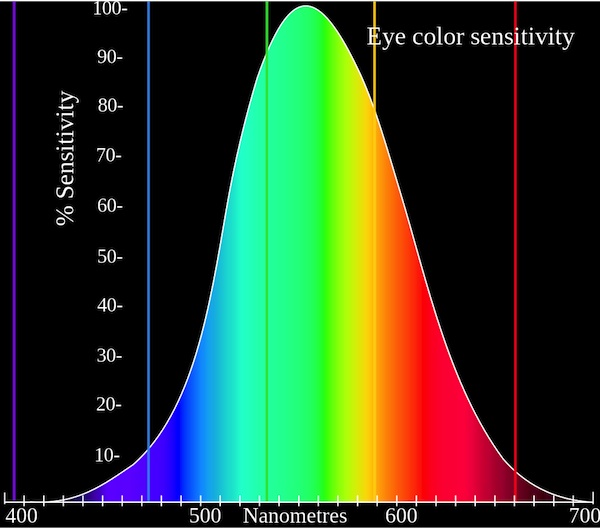
- Graph: Adam Rędzikowski, Wikipedia Commons
But what if I look at that same colorful scenery on a dim evening. All of the same wavelengths of light are still hitting my eye, but at much lower luminance. Now only the rod cells (what we think of as the black-and-white sensing cells) in my eye are working. Logic would suggest they should also be most sensitive to green light, but they aren’t. They’re more sensitive down in the blue area.

- The Rod cells (gray area) are more sensitive to blue light.
Does it make a difference? Actually it does, a little bit. For example if you put some red apples in a blue bowl, the fruit will look brighter than the bowl in daylight. In dim light, after your eyes have acclimated, the bowl will look brighter than the fruit. Yeah, I know this is pretty useless, but now when your wife asks if you’re reading that stupid photography blog again you can say “No! I’m doing science!” and threaten to show her what you’ve learned.
This principle can help a bit when we convert color images to black and white. Below are an image of a carousel in color, after a standard black-and-white conversion, and converted to black-and-white with green emphasized (like daylight vision) and blue emphasized (like night vision). They are slightly different.
Look at the stripes on the pole in the foreground or the trim on the ticket-taker’s booth. Default black-and-white conversion can lose some details that our actual vision would never lose. Playing around with Channel Mixer for your black-and-white conversions, starting with a green or blue emphasis, will often be more realistic than the standard ‘convert-to-grayscale’ conversion.

Vision Processing and Why I Like to Work in LAB
I promise not to go all neurophysiologist on you (those guys are geekier even then me, and can spend hours arguing over things like opponens-processing theory and close-area inhibition). But there are some interesting things about vision processing we can discuss without going there.
Visual information leaves the eye along the optic nerve and travels to the middle of the brain (the thalamus) for preliminary image processing and then to the back of the brain for more intensive processing. The anatomy and stuff aren’t particularly important for my purposes, so we’ll just skip over the 30,000 words it would take to describe them all. I will mention that “blob cells” and “interblob cells” are involved, just because I found those names awesome compared to Latin terms like Lateral Geniculate Nucleus, koniocellular neurons, and extrastriate cortex. Those latter terms can be useful, though. If you want to share the carrot story, for example, you’ll sound a lot smarter if you say something like, “I was reading about vision processing in the Lateral Geniculate Nucleus and koniocellular neurons yesterday, and discovered that carrots aren’t really good for your eyes.”
Anyway, the bottom line (well, one of the bottom lines) is the brain separates out visual information into two different major streams.
- The first stream (called the dorsal or ‘where’ stream) processes images in monochrome. It detects luminance and high resolution, has binocular vision with depth perception, locates objects in 3 dimensions and tells us how they are moving (or not moving).
- The second stream (called the ventral, or ‘what’ stream) processes the color and shape of objects (it’s very sensitive to edges) and connects with other centers of the brain that identify objects. The ‘what’ stream is actually of much lower resolution than the ‘where’ stream.
People who suffer damage to these areas of their brain have very strange problems. When the ‘where’ system is damaged, for example, the person may find it impossible to cross a street — they can see a car coming but have no idea how far away it is or how fast it is travelling. When the ‘what’ system is damaged people may no longer see colors or may not recognize objects. They might describe the parts of a person’s face (blue eyes, thick eyebrows, large nose) but not be able to recognize that person is their brother. (If you find this kind of thing interesting, I highly recommend “The Man Who Mistook His Wife for a Hat, and Other Tales” by Oliver Sacks.)
What does this have to do with why I like to work in theLAB colorspace (as opposed to the standard RGB) when I’m playing in Photoshop? One reason is because LAB separates an image much like the brain does, into a high resolution monochrome image (the Luminance channel of LAB) and two lower-resolution color channels (the A and B channels of LAB).
For those of you who aren’t familiar with it, let me show you a quick example. The image below shows a flower, with the Luminance channel and combined A and B channels separated out below it.

- Normal image (top); combined AB color channels (bottom left) and Luminance channel (bottom right)
If you haven’t worked in LAB before, or haven’t studied color theory in art school, you might be shocked at how little information the two color channels seem to contain compared to the luminance channel. Now you understand why some video codecs (and jpg for that matter) can compress the hell out of the color information without affecting the image all that much. You also understand why those rare neurologic conditions that cause loss of luminance perception but retained color perception, leave their victims nearly blind. (Human vision isn’t quite like this; our color vision emphasizes edges, but it’s similar.)
Just in case you think that color information isn’t important in everyday life, though, try to identify 10 of the fruits in this black-and-white image.

Yeah, you were pretty lost after pineapple, weren’t you? I didn’t think so. Adding that low resolution color makes an impressive difference, doesn’t it? It also is a good example of why primates, who loves them some fruit, had an advantage with color vision over the monochrome mammals.

Fun in LAB
While the LAB color space in Photoshop isn’t necessarily better than the the RGB most people work in, it lets you do some things you could never do in RGB because you can basically manipulate the heck out of the color channels. For example, if I invert the flower photo from above in RGB I get the image on the right, while if I invert the color channels in LAB I get the image on the left. Pretty different.
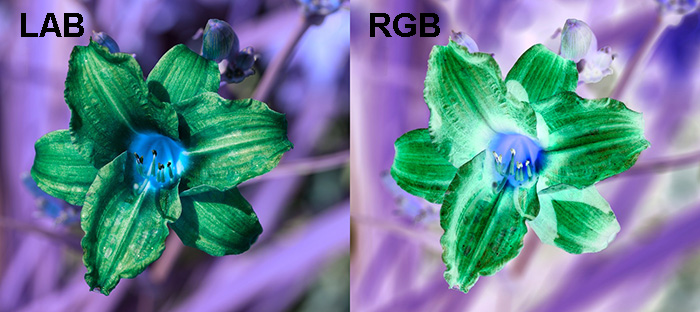
Or I could just invert the B channel and get this. Just the ticket if I want to make everything look like a scene from “Avatar”.

Or if you like oversaturated colors, you can do it to a huge degree in LAB because you can manipulate the heck out of those color channels without adding noise or blowing out highlights or shadows. Accomplishing the same thing in RGB would cause all kinds of artifacts in your image.

Why would you want to do any of this? I don’t know. But there are things that can be done much more easily in LAB. Restoring unrecoverable blown highlights, sharpening images that have chroma noise (or reducing chroma noise), artificially coloring images, and a number of other things are easy as pie in LAB. Of course, there are other things that are easier in RGB. I think.
Fun with Luminance and Color
Those of you with fine art degrees already know most of this section, but those of us who aren’t so trained may find it interesting.
(Note: all of the images below depend on your computer’s monitor settings and your own visual perception. You may not see the effects I describe.)
Equiluminant Colors
Painters have taken advantage of the fact that the position and motion sensing parts of vision processing work on the luminance of the image, while object recognition may depends more on color and shape, for a long time. A classic example is Monet’s “Impression, Sunrise“.

- Impressioin, Sunrise Claude Monet, 1872
The sun is very dramatic. A lot of people, if they look at the picture for a while, see the sun seem to twinkle or vibrate a bit. If you look at the luminance of the image you can see why: the sun is nearly equiluminant with the sky around it. The position sensing part of the brain doesn’t have good data to say exactly where the sun is, but the object sensing part of the brain sees it very clearly.

- Impression, Sunrise, luminance
A lot of impressionist artists used this technique, although Monet was the master at it. His “Wild Poppies Near Argenteuil” does exactly the same thing with the poppies in the image, making them seem to almost move in a breeze. (I’ll let you do the grayscale on this one.)
One other nice technique here is that the foreground flowers aren’t quite equiluminant so they grab the eye, while the background, equiluminant flowers emphasize the sensation of distance.

"Wild Poppies Near Arenteuil", Monet, 1873
I know most of you don’t plan on painting anytime soon, but you can use this technique to modify a photograph of sunsets, flowers, or other colorful objects, using a ‘lighten’ or ‘darken’ brush to move the Luminance more towards neutral, and perhaps boosting the color channels a bit. A hint, though: only work in areas of mid-luminance. You’ll get color artifacts if you do it in areas of shadow or highlight.
Equiluminance for Fun and Profit
Equiluminance is one of the simple techniques used in optical illusions. The boxes below, for example, are color only, the luminance of both the orange squares and the gray background is 50%. The orange squares are square, but depending upon exactly how your brain processes things, they may have a halo or edges around them, may appear tilted, or jittery.
It’s In general, it’s just kind of hard to look at. Eye movement is controlled by the part of the brain that senses luminance and with no luminance to grab on to, it has trouble controling conroling where to send your eyes as you look around the square.

Now why on earth would anyone want to make something that’s so difficult to look at? One reason is because they want to sell you stuff. In the example below, the text is equiluminant and therefore quite difficult to read. So guess what we curious humans do when confronted by difficult to read text? We read it slowly. One. Word. At. A. Time. And that makes us more likely to retain the message. If it is a screaming, black-and-white headline our brains would immediately recognize it and discount it.
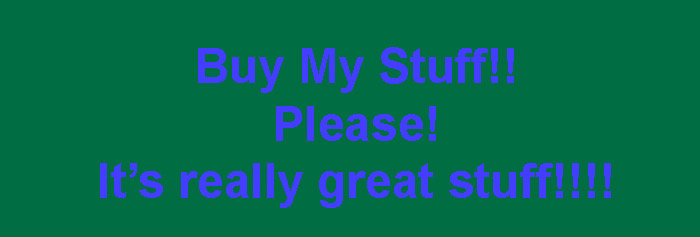
Generally an advertiser isn’t this blatant. They’d put the equiluminant text in with some graphic art, or perhaps even as part of a photograph. Or they use other tricks like different colored or different sized letters, putting the text on curved lines. But advertisers know if we don’t immediately recognize text we’ll spend a few seconds figuring out what it says. Every time.
Luminance Shading and 3-D
I mentioned earlier that the ‘Where’ system that is responsible for locating objects in space is monochromatic and luminance dependent, while the ‘What’ system that helps recognize objects recognizes colors and edges. If you look at the circles below, two have a bit of 3-D effect while the one on the right appears perfectly flat.
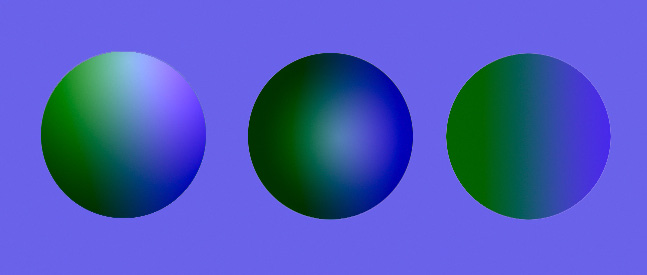
You probably won’t be a bit surprised to find that luminance has a lot to do with the 3-D effect, with the two balls on the left having luminance changes, while the one on the right has none, as shown in their Luminance channel below.
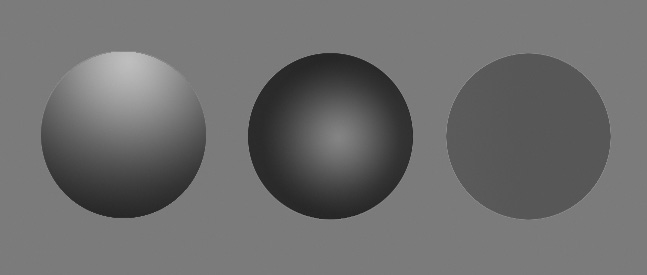
- The Luminance channels for the image above.
If I show you the two color channels, you’ll see the three balls are identical as far as color goes. (In fact, the way I made the drawing was to draw a ball using a blue-green color gradient, copy it three times, make black-white gradients in just the Luminance channel.)

- The A and B channels for the balls in the illustration above. All 3 balls have identical color.
The take away message is you can’t give objects a 3-D look with color, it’s entirely a luminance thing. (Shading a color from light to dark is entirely a luminance thing, too. The color doesn’t change, simply the amount of luminance of the color.) There are many other factors, such as perspective, shading, and haze that go into depth perception, but this aspect of an object’s 3-D shape is basically luminance.
For the same reason, a bizarrely colored face with unchanged luminance, is simply a bizarrely colored face. We have no trouble recognizing what it is or even who it is.

If you paint something with huge differences in luminance, though, it becomes difficult to recognize. That’s the main entire concept of “dazzle camouflage” used on ships since World War II (and as recently as 2013 on the USS Freedom). Dazzle doesn’t particularly hide the ship (or other object), it makes it difficult to tell what the object is, and how it is moving.

- USS Charles S. Sperry in “Dazzle” camouflage paint
There’s a million other fun things that separating color and luminance do to our vision. And there’s a lot more than just color and luminance to visual processing. But this little bit, this, hopefully, provided a ‘fun fact’ or two you didn’t already know.
Roger Cicala
Lensrentals.com
August, 2013
